从微信小程序到鸿蒙js开发【04】——list组件 原创 精华
1、可滚动区域
在许多场景中,页面会有一块区域是可滚动的,比如这样一个简单的每日新闻模块:
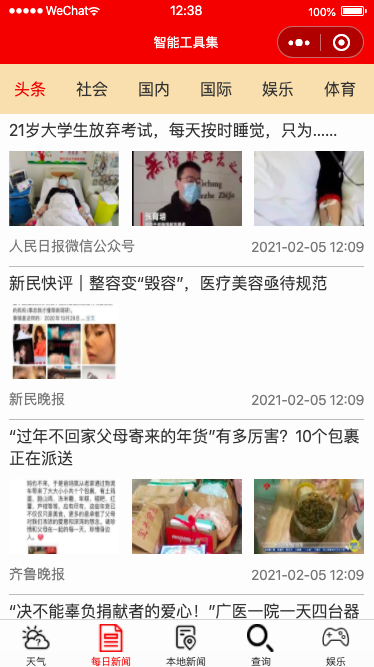

上面的新闻类型是一块可横向滚动的区域,下方新闻列表是一块可竖向滚动的区域。在微信小程序中,使用scroll-view组件即可实现。那么在鸿蒙js组件中,想要实现可滚动的区域,则是使用list组件。list仅支持竖向滚动,横向滚动要用tabs,将在下篇博客讲解。
2、list + list-item
这里以本地新闻模块为例,数据请求自天行数据接口(https://www.tianapi.com/apiview/154)。
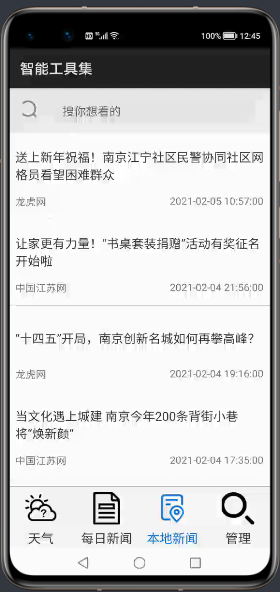
上方为一个搜索框,下方是新闻列表。搜索框给了固定高度,那么怎样让新闻列表能够占满屏幕剩余部分呢?只需将父容器设置flex布局,list设置flex: 1即可。list下直接放list-item,在总高度超出list的高度后,即可上下滚动。
hml:
<!-- 本地新闻 -->
<div>
<div class="searchView">
<image src="{{ searchIcon }}"></image>
<input placeholder="搜你想看的"></input>
</div>
<list class="localView">
<block for="{{ localNews }}">
<list-item class="newsItem">
<div class="newsContent">
<text>
{{ $item.title }}
</text>
<div class="newsDesc">
<text>
{{ $item.source }}
</text>
<text>
{{ $item.ctime }}
</text>
</div>
</div>
</list-item>
</block>
</list>
</div>
<!-- 本地新闻end -->css:
/*本地新闻*/
.searchView {
width: 100%;
height: 140px;
background-color: #f0f0f0;
display: flex;
align-items: center;
}
.searchView>image {
margin: 0 40px 0 40px;
height: 60px;
width: 60px;
}
.searchView>input {
margin-right: 40px;
}
.localView {
width: 100%;
flex: 1;
display: flex;
flex-direction: column;
}
.localContent {
margin-left: 20px;
}
.newsItem {
width: 100%;
height: 240px;
border-bottom: 1px solid #bbbbbb;
display: flex;
align-items: center;
}
.newsContent {
display: flex;
flex-direction: column;
margin-right: 20px;
margin-left: 20px;
}
.newsContent>text {
margin-top: 20px;
height: 140px;
font-size: 34px;
color: #333333;
}
.newsDesc {
height: 60px;
line-height: 60px;
display: flex;
justify-content: space-between;
}
.newsDesc>text {
font-size: 28px;
color: #777777;
}js:
searchLocalNews() {
let url = 'http://api.tianapi.com/areanews/index?key=xxxx&areaname=江苏';
if (this.searchWord) {
url = url + '&word' + this.searchWord;
}
fetch.fetch({
url: url,
responseType: 'json',
success: res => {
let data = JSON.parse(res.data);
this.localNews = data.newslist;
}
})
},新闻列表可滚动,且不会影响搜索框的位置。
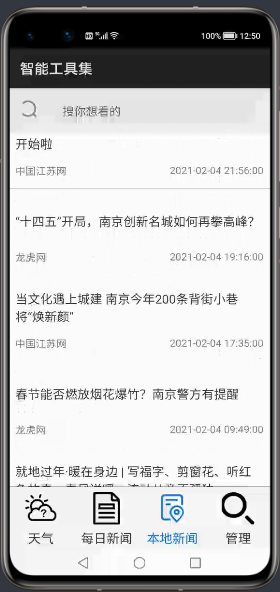
3、list + list-item-group + list-item
list组件的子元素还可以是list-item-group,顾名思义应是分组列表项,list-item作为list-item-group的子元素。随便写一点看一看:
<div>
<list class="manageList">
<list-item-group class="list-item-group">
<list-item class="list-item">
<text>
<span>分组1 子项1</span>
</text>
</list-item>
<list-item class="list-item">
<text>
<span>分组1 子项2</span>
</text>
</list-item>
<list-item class="list-item">
<text>
<span>分组1 子项3</span>
</text>
</list-item>
</list-item-group>
<list-item-group class="list-item-group">
<list-item class="list-item">
<text>
<span>分组2 子项1</span>
</text>
</list-item>
<list-item class="list-item">
<text>
<span>分组2 子项2</span>
</text>
</list-item>
<list-item class="list-item">
<text>
<span>分组2 子项3</span>
</text>
</list-item>
</list-item-group>
</list>
</div>.manageList{
height: 100%;
width: 100%;
}
.list-item-group{
width: 100%;
height: 450px;
}
.list-item{
width: 100%;
height: 150px;
display: flex;
justify-content: center;
align-items: center;
border-bottom: 1px solid gray;
}
.list-item>text{
line-height: 100px;
}
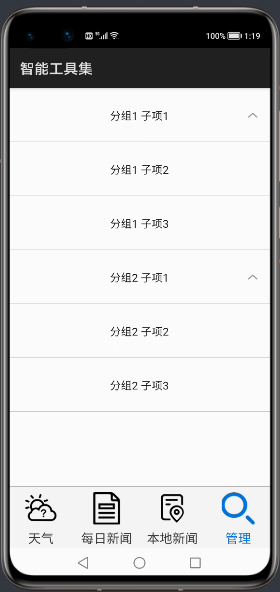
可以看出,list-item-group是可折叠的列表分组,且默认是折叠的。点击右侧小箭头可展开列表,如果list-item-group给了高度,则折叠和展开后这一块区域的高度不变。在折叠时,展示第一个list-item的内容。
那么如果每一个list-item-group中list-item数目不固定,在展开后的布局就会很难看。如下:
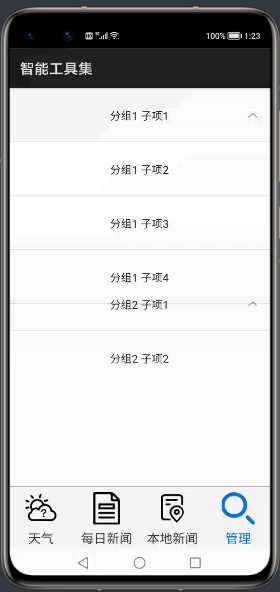
其实不定义list-item-group的高度即可,折叠高度为list-item的高度,展开后高度自适应增长,超出list高度可以滚动,功能还是很强大的。更改css后的效果如下:
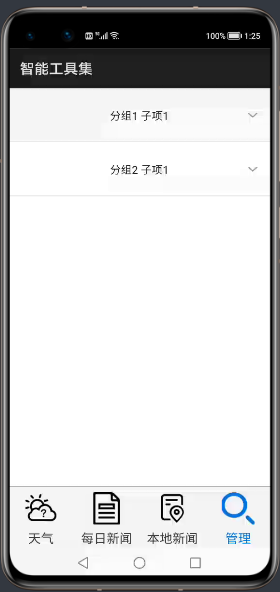
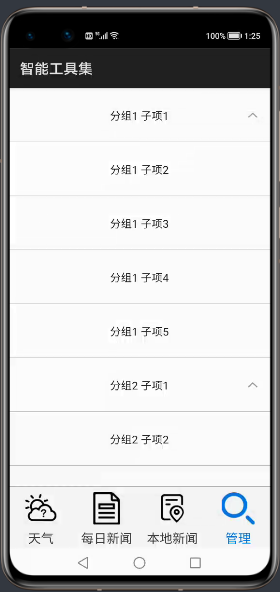
这种分组的列表,可以制作一个简单的后台管理系统菜单界面。这里我将菜单数据文件、图片文件放入nginx服务器的目录中,再通过内网穿透访问资源。注意数据的格式,list-item-group和list-item之间存在父级标签关系,故数据中也应存在父级关系。list-item-group展示的内容是其下第一个list-item,这里用一个两重for循环实现:
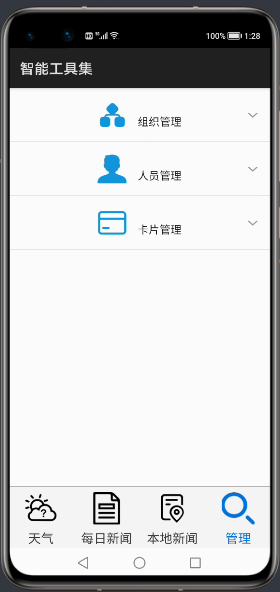
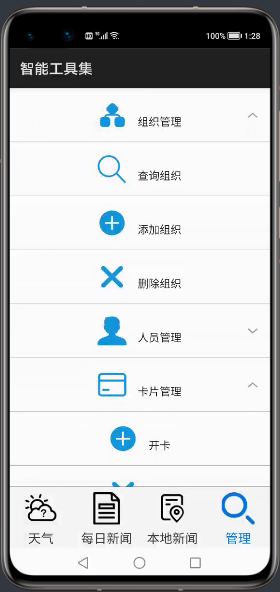
manage.json:
{
"manageList": [
{
"name": "组织管理",
"icon": "http://milkytea.free.idcfengye.com/images/christools/icon/org.png",
"subList": [
{
"name": "查询组织",
"icon": "http://milkytea.free.idcfengye.com/images/christools/icon/search.png"
},
{
"name": "添加组织",
"icon": "http://milkytea.free.idcfengye.com/images/christools/icon/add.png"
},
{
"name": "删除组织",
"icon": "http://milkytea.free.idcfengye.com/images/christools/icon/delete.png"
}
]
},
{
"name": "人员管理",
"icon": "http://milkytea.free.idcfengye.com/images/christools/icon/person.png",
"subList": [
{
"name": "查询人员",
"icon": "http://milkytea.free.idcfengye.com/images/christools/icon/search.png"
},
{
"name": "添加人员",
"icon": "http://milkytea.free.idcfengye.com/images/christools/icon/add.png"
},
{
"name": "批量导入人员",
"icon": "http://milkytea.free.idcfengye.com/images/christools/icon/add.png"
},
{
"name": "删除人员",
"icon": "http://milkytea.free.idcfengye.com/images/christools/icon/delete.png"
},
{
"name": "修改人员",
"icon": "http://milkytea.free.idcfengye.com/images/christools/icon/update.png"
}
]
},
{
"name": "卡片管理",
"icon": "http://milkytea.free.idcfengye.com/images/christools/icon/card.png",
"subList": [
{
"name": "开卡",
"icon": "http://milkytea.free.idcfengye.com/images/christools/icon/add.png"
},
{
"name": "退卡",
"icon": "http://milkytea.free.idcfengye.com/images/christools/icon/delete.png"
}
]
}
]
}hml:
<!-- 管理 -->
<div>
<list class="manageList">
<block for="{{ manageList }}">
<list-item-group class="list-item-group">
<list-item class="list-item">
<image src="{{ $item.icon }}"></image>
<text>{{ $item.name }}</text>
</list-item>
<block for="{{ (index, value) in $item.subList }}">
<list-item class="list-item">
<image src="{{ value.icon }}"></image>
<text>{{ value.name }}</text>
</list-item>
</block>
</list-item-group>
</block>
</list>
</div>
<!-- 管理end -->js:
getManageList() {
let url = "http://milkytea.free.idcfengye.com/text/manage.json";
fetch.fetch({
url: url,
responseType: 'json',
success: res => {
let data = JSON.parse(res.data);
this.manageList = data.manageList;
}
})
}



















大兄弟 太详细了!
果然一出手,都是精华,继续期待中